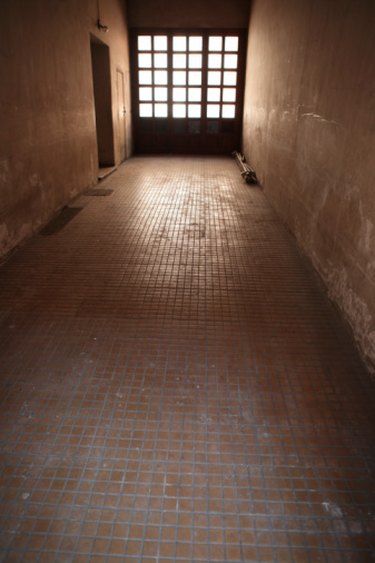
Mortar and grout have many things in common. Both products, for instance, have Portland cement as their base ingredient and are used in construction. Also, when applied, the grout and mortar harden to aid with durability and strengthening of brick or tile. Despite their similarities each achieves different goals in construction projects, so using mortar instead of grout or vice versa may ruin any construction project.
Water
Video of the Day
Mortar and grout differ in consistency. Mortar's ingredients consist of cement and aggregate such as sand and lime. Grout, on the other hand, consists of cement and sand. Mixing both products requires water but grout requires a larger amount of water in the mix than mortar. Thus, when mixed, grout appears like a soupy, pourable mixture.
Video of the Day
Since mortar requires less water, it resembles a paste. Mortar becomes a paste to easily stick to a trowel before applying it to a project. Therefore, too much water may ruin the mortar mixture making it too soupy to place on a trowel without it dripping. With some projects such as tiling floor, grout requires no trowel. The individualcan simply pour the grout mixture directly onto the floor before spreading it with a rubber-bottom float.
Uses
Grout and mortar differ in their use in the types of construction or home improvement projects. For example, tiling floors and wall involves using grout. However, constructing structures such as walls or buildings entail using mortar. Using mortar between bricks, stones or blocks prevents moisture and air from destroying the structure and using grout protects projects from water seeping under or around tiles.
Purpose
The products serve different purposes. One acts as the filler and the other a type of adhesive. Thus, grout cannot substitute for mortar in construction projects because their differences. Mortar, a type of binding agent, makes two objects hold together. When building a wall an individual applies mortar on each side of the brick or stone to keep them together. However, grout isn't a binding agent. Instead the product fills the spaces between the tiles.
Grout and Mortar Considerations
Grout dries quicker than mortar because it doesn't need to cure like mortar does. The curing process stiffens the mortar before it hardens, removing the rest of the water in the mix. The curing process helps objects permanently sticking together. Thus, using mortar instead of grout may lead to water leakage. Mortar is too stiff to flow around steel, into small cavities or cores without leaving voids, reports the website Masonry Construction Online. When mortar stiffens voids appear. The voids, also called holes, allow water to seep between and underneath tiles causing damage such as mold.